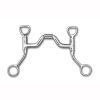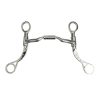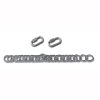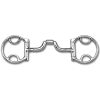Snaffle Bits
There are dozens and dozens of variations in terms of bit design, but they can all be sorted into a few main groups, which include direct pressure bits that don’t use leverage, leverage bits (also known as curb bits), combination bits and non-curb leverage designs (commonly known as gag bits). However, by far the most common type of bit used when riding a horse is the snaffle bit, which falls under the first category just mentioned. In fact, almost every horse will experience using a snaffle bit at one point or another in their lifetime. So exactly what are snaffle bits?

What Are Snaffle Bits?
Fundamentally, a snaffle bit, as we’ve already mentioned, is any bit that applies direct pressure and doesn’t use leverage. There is a huge range of snaffle bits available, but the core structure is always the same. They feature two main parts; a mouthpiece and rings on either end of the mouthpiece that attach to the reins. Many people often make the incorrect assumption that any bit that has a jointed mouthpiece is automatically a snaffle bit and that all bits with single-piece mouthpieces are curb bits. This of course isn’t true; as already mentioned, it’s the fact that only direct pressure is utilized as opposed to leverage, that makes a bit a snaffle bit.
How Do Snaffle Bits Work?
While there is considerable variation in terms of snaffle bit design – some mouthpieces are extremely thick, while others are very thin – most experienced horse trainers consider snaffle bits to be one of the milder bit types.
As we’ve already pointed out, snaffle bits are fairly basic in terms of design and use direct pressure to communicate with the horse. This means that for every pound of pressure that you exert on the reins, the exact same amount of pressure is exerted on the horse’s mouth (i.e. one pound in this case).
How Myler Have Created a Superior Range of Snaffle Bits
Myler bits differ to many other types of snaffle bits in terms of where that pressure is applied. Creators of other types of snaffle bits based the design on the belief that horses evade bar pressure and when pressure is exerted on the reins, much of the pressure that is applied to the horse’s mouth will fall on the bars. The design of Myler bits mainly concentrates pressure on the tongue of the horse and aims to completely prevent pinching of the lips and bars, since the creators of the Myler bitting system, Dale, Ron and Bob Myler, firmly believe that horses seek to evade tongue pressure rather than bar pressure. This belief is backed up not only by years of experience in training horses, but also by the behavior demonstrated by horses themselves. When you see a horse resisting their bit, they will almost always perform an action that releases tongue pressure, while at the same time perhaps increasing bar pressure, contradicting the theory that bar pressure is what they try to avoid.
With the snaffle bit in place, when the rider wants to communicate with the horse he simply gives the relevant command using the reins, concentrated tongue pressure is applied to the horse via the Myler bit, and once the horse complies with this command the tongue pressure is instantly released, thus rewarding its efforts. Myler bits utilize a progressive system (Could link to Myler section about levels here) whereby the horse advances through several different levels of bit as it learns to respond to tongue pressure and obey commands, with the more tongue relief being provided in the advanced level bits.
The Different Types of Snaffle Bits
As we’ve already touched upon, snaffle bits come in a wide variety of designs, with there being many different types of cheek pieces and many different types of mouthpieces that can be combined to form the bit. Below we’re going to talk about some of the most common cheek piece designs.
O-Ring Snaffle (Loose Ring)
Also often referred to as loose ring snaffles, this type of snaffle ring isn’t fixed into place; the rings are able to move independently of the mouthpiece, meaning the bit can move with the horse’s jaw and tongue, as opposed to completely restricting the horse’s mouth. This can help to keep the horse calm and relaxed, and it’s this attribute, combined with the fact that O-ring snaffle bits offer sensitive contact through the reins, that make it ideal for dressage events. Although this freedom of movement isn’t ideal for every horse and can lead to the horse becoming too playful, especially when the reins are slack.
O-rings are one of the most popular types of snaffles used and are often used on younger horses while they are learning basic skills, although they’re not recommended for novice riders as it’s imperative to ride two-handed. Any O-ring measuring between 2.5" and 3" can be legally used in a wide range of horse shows, including dressage and eventing. One thing that you should be careful of when purchasing an O-ring snaffle is buying one with a large gap between the rings and the holes in the mouthpiece (i.e. one that features thin rings and large holes), as this often results in loose-skinned lips getting pinched, causing the horse considerable pain and distress. Myler bits are designed specifically to avoid this problem.
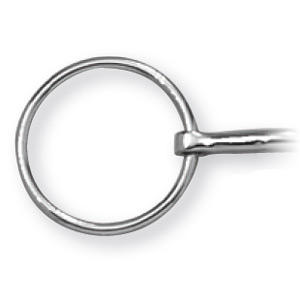
D-Ring Snaffle (Western/English Dee)
When you pick up an o-ring and a d-ring snaffle bit, the first thing you’ll notice, apart from the different shaped rings, is the fact that on a d-ring snaffle, the rings are fixed into position. This fixed position reduces the sensitivity of the bit, but the vertical shanks provide more lateral control, which helps with turning. It’s effectively a compromise between an eggbutt and a full cheek snaffle bit.
How does this difference in design affect how the bit works? Well, the pressure is spread across a wider area of the horse’s mouth, and while it isn’t as sensitive as an o-ring snaffle (which makes it less suitable for dressage), it offers a high degree of control, which is why it’s heavily used by inexperienced riders, as well as in high energy activities that require a great deal of control, such as horse racing and jumping. The lack of movement of the rings mean that the horse has less warning that the rider has picked up the reins, but the fixed design also means that the bars and lips of the horse are far less likely to get pinched.
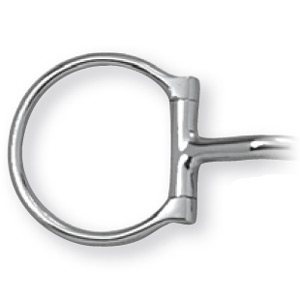
Eggbutt Snaffle
Named after the oval shaped connector that brings the mouthpiece and cheek pieces together, the eggbutt snaffle is one of the milder types of bits available. You will see the eggbutt snaffle used across multiple disciplines (although it’s not often used in western riding) and its design results in it being a comfortable option for many horses. While the rings on a loose ring snaffle are able to move independently of the mouthpiece, which often leads to the lips of the horse getting pinched (causing pain and distress to the horse), an eggbutt snaffle has a mouthpiece with flared ends that attach to the rings using a swivel joint. There is no space whatsoever between the ring and the mouthpiece, meaning the lips won’t get caught or pinched.
The design of an eggbutt snaffle has two further advantages over other types. Firstly, when the rider pulls the reins in a lateral direction, a moderate amount of pressure is felt by the horse on the other side of the cheek, which encourages it to turn. Secondly, the design of an eggbutt snaffle makes it far less likely that the ring will be pulled through the mouth, which is a problem with other kinds of cheek pieces, such as the loose ring snaffle. The fixed position of the cheek piece also helps to keep the bit in a more stationary position inside the horse’s mouth, which can be beneficial should the horse not have sufficient confidence to stretch into the contact.

Full Cheek Snaffle
A full cheek snaffle, so called due to a design that features a lengthy arm that extends both upwards and downwards perpendicular to the mouthpiece, it is often used on horses that are not very respondent to rein pressure and that tend to have difficulty turning. The design of a full cheek snaffle increases the amount of lateral pressure that is placed on the horse’s mouth, which encourages the horse to turn, and it’s more or less impossible for the snaffle to be pulled through the mouth.
There is one common issue experienced with full cheek snaffle bits though; the long arms that characterize the bit can get caught up with the reins and leg wraps, leading to inconvenience and potentially dangerous situations. To counter this problem, a restraining loop is placed on the bridle, which secures the cheek piece in place by fastening to one of the arms.
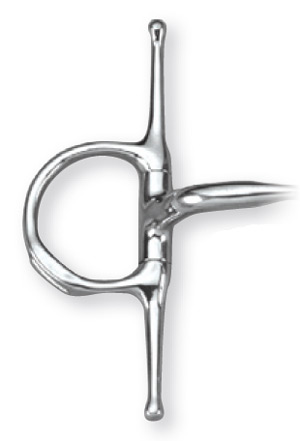
Half-Cheek Snaffle
As its name implies, the half cheek snaffle has only a single (most often lower) cheek compared to the full cheek. This lower cheek is usually flatter than a full cheek and has a somewhat spoon-like appearance. For this reason it is sometimes called the “half-spoon snaffle”. Though it may only have a single rather than a double cheek the guiding principle of the half cheek is the same as that of its full cheek counterpart: more effective lateral guidance and decreased likelihood that the bit will be pulled through the horse’s mouth (as may happen with the eggbutt or O-ring bits). The actual effectiveness of the half cheek to provide leverage, and hence lateral guidance, is debated among trainers although most agree there is some benefit. The half cheek also has a reduced likelihood of being caught on anything external and because of this it is not an uncommon site at racing or driving events as well as in saddle seat competitions where it is commonly put into service on younger horses. But while it is generally less prone to external entanglements than the double cheek, the possibility exists nonetheless and so proper precautions should always be taken to minimize potential snare incidents.

Baucher or “Hanging Cheek” Snaffle
Named after its inventor – 19th century French riding and dressage master Francois Baucher – the Baucher snaffle exemplifies his belief that the horse’s body should be compressed and high in the front (in spite of the negative effects such a posture has on impulsion). To effect that profile Baucher developed a bit comprised of two rings joined by a metal bar, with the upper attached to the cheek piece and the bit ring seeming to ‘hang’ below it: hence the term “Hanging Cheek”. The Baucher typically retains a very fixed position, which its creator believed aided in proper flexion at the poll but which can also be useful if the horse has a naturally busy mouth. The Baucher has a reputation in some circles for being too harsh for dressage use while others object to what they consider the crude or tricky way is achieves results.
In general the Baucher will provide a bit more leverage than other snaffles which can be a significant attribute, particularly when dealing with older horses displaying resistance to retraining or draft horses that are naturally less amenable to flexion. Experience states that horses tend to have one of two reactions to the Baucher: they either love it or hate it. The latter reaction is often produced in horses with sensitive palates. If a horse exhibits such a negative response to the bit and good faith efforts to adjust the bit to the horse’s satisfaction are unsuccessful, the horse should not be compelled to use the Baucher.
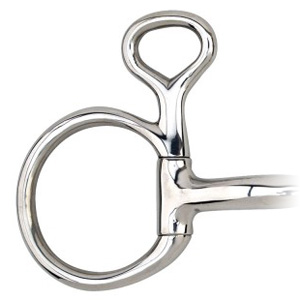
Wing Cheek
A relative newcomer to the bit landscape, the wing cheek has made its name (literally) through the use of “winged” ends that present a smooth surface at the corner of the horse’s mouth. For all intents and purposes the wing cheek is a form of bit guard preventing the rings from pinching and otherwise irritating the corner of the horse’s mouth. Though the wing cheek typically offers slightly more restricted ring action than a loose ring bit, the freedom it does allow is still significantly more than you would get from an eggbutt or D-ring, while offering the added benefit of protecting the horse’s mouth. Lauded for its sensitivity and gentleness as well as how easily it is accepted by less experienced horses, the wing cheek has found a niche in the marketplace and is likely here to stay.

The Different Types of Mouthpieces
As we’ve already mentioned, snaffle bits are comprised of two main parts; the rings or cheek pieces, which we’ve just discussed, and the mouthpiece. The mouthpiece is what fits into the horse’s mouth during use, and just as with snaffle cheek pieces, there are many different kinds that can be used on a bit. Some of the main ones are outlined below.
Mullen Mouth

Of all of the different types of mouthpieces that can be used on a snaffle bit, the mullen mouth is the only one that does not feature some sort of joint. The traditional mullen mouth is essentially a straight bar, but the Myler mullen mouth snaffle features more of a curved bar, which allows more room for the tongue as well as fitting more comfortably in the horse’s mouth. The Myler version also has a feature called independent side movement (link to section about features of Myler bits), meaning each side of the mouthpiece can be controlled independently.
Single Joint

Widely regarded as the most commonly used type of mouthpiece in a snaffle bit, the design of a single jointed mouthpiece offers the ability for each side of the mouthpiece to operate independently of one another. This allows greater sensitivity and better control over lateral flexion. The problem with this type of mouthpiece is the "nutcracker" action that can occur due to the joint, which can potentially drive upwards or downwards and pinch the tongue and other parts of the mouth, distracting the horse and increasing the likelihood it will resist your commands.
French Link

Another common type of mouthpiece used on snaffle bits, the French link features two joints, which helps to reduce the impact and potential harm caused by the nutcracker effect, while still providing the rider with greater control owing to the fact that each side of the mouthpiece operates independently. The "connector" at the center of a French link mouthpiece is known as a "flat spatula" and is designed in such a way that it isn’t driven downwards into the tongue at an angle, which is something that is common with Dr. Bristol mouthpieces and single joint mouthpieces. If this central connector is oval shaped, it is known as an oval mouth double jointed snaffle.
The Dr. Bristol

A type of double jointed mouthpiece common to snaffle bits, the Dr. Bristol while similar to the French link, also exhibits considerable differences. For instance, when used with a full cheek the plate which straddles the center between the joints lays flat or nearly flat on the horse’s tongue relieving pressure and allowing the horse to breathe, swallow and salivate more naturally. Yet when used with an eggbutt or D-ring the plate reverts to its natural angled profile with the edge of the plate exerting direct and concentrated pressure on the tongue while a twisting action is instigated which many consider extremely severe. At the same time secondary pressure is applied to the lips and bars. The Dr. Bristol is rarely used in dressage.
Slow Twist

The slow twist is designed, like all twisted snaffles, to be a more severe mouthpiece. As the name indicates it incorporates a slight twist intended to bring more bite to the tongue. It has a limited number of functions and is used primarily to get the attention of an otherwise unresponsive horse. On occasion a trainer will start a new horse with a slow twist because the added bite means less rein tension is needed to get the horse to respond. Once the horse has developed the habit of yielding to the lighter pull the slow twist is then replaced with a smooth snaffle and training progresses. It should also be noted that a slow twist is not a wire or corkscrew bit even though it may share some visual similarities.
Roller

Roller mouthpieces come in a variety of styles but are all intended to relax the tense horse through activation of the tongue. Increased salivation produced by the action of the rollers against the tongue helps the horse accept the bit and achieve a relaxed state quickly and easily. Cherry and Cricket are two popular types of roller mouthpiece. The Cherry presents multiple rollers along its length and is not permitted in dressage events, while the Cricket incorporates only a single roller and is legal for some types of competition, mostly in the US.
Hollow Mouth

Horses often respond favorably to the hollow mouthpiece due to its light weight. In order to maintain structural integrity however the hollow mouth must present a thicker diameter along its length and for that reason may not be appropriate for smaller horses. The thicker, lighter design of the hollow mouth is intended to both reduce weight and diffuse pressure on the tongue and so is considered to be a less severe mouthpiece. But some horses develop the habit of chewing on what is essentially a pliable tube in their mouth and so the hollow mouth needs to be checked for damage on a regular basis for the horse’s own protection. The fact that it is thicker than the average mouthpiece also means that you should avoid using it with a flash noseband since this combination may wind up restricting the horse’s ability to swallow.
Corkscrew

A narrower mouthpiece than most the corkscrew is considered appropriate for difficult horses: those with a tendency to pull and a history of resistance to hand communication. Horses that lean on the bit are also considered good candidates for the corkscrew. The corkscrew incorporates a series of ridges that revolve in a corkscrew type manner (hence the name) and deliver greater than average pressure to the lips, bars and tongue. This added pressure is intended to encourage the horse to respond quicker and provide the rider with greater control. Though fairly common in driving and assorted English disciplines the corkscrew is not allowed in dressage events.

